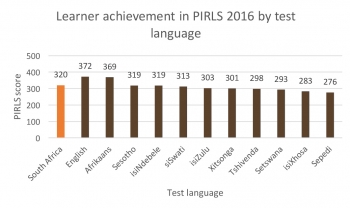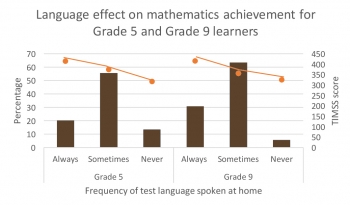Building solid language foundations for achievement
Research has consistently shown that language is an important factor in how learners perform academically. As a multilingual country, South African research provides unique insight into the effect of language on learner achievement. The Trends in International Mathematics and Science Study (TIMSS) 2015 included a number of items related to language the help us understand its influence on achievement. Jaqueline Harvey discusses the findings for grade 5 and grade 9 learners.
Children encounter the worlds of mathematics and science through language. In the classroom setting, it is through the language of instruction that teachers help learners make connections between abstract symbols and their meaning. In South Africa, there is a mismatch between home language and instructional language for the majority of learners.
Despite clear policy aims to remedy the undervaluing of African languages, the common practice is to switch from home language instruction to English, or to a lesser extent Afrikaans, from grade 4 onwards. This privileges learners who are English or Afrikaans home language speakers.
Learners who speak other languages at home must learn their new instructional language (attain literacy) at the same time that they are trying to learn the curriculum content. This is a huge burden placed on teachers and learners. It is therefore likely that academic achievement would be impacted upon.
What can large scale assessments tell us?
The Progress in International Reading Literacy Study (PIRLS) 2016 showed that literacy rates in general are low. PIRLS 2016 assessed grade 4 learners on their literacy ability with the results placing South African learners last out of all participating countries. When learners were separated according to language, those who spoke and were tested in an African language achieved significantly lower scores than English and Afrikaans speaking learners (Figure 1). A possible reason is that African language speaking learners are more likely to come from low socio-economic backgrounds and attend poorly resourced schools, limiting their literacy development. Furthermore, there are fewer resources available in
FIGURE 1: THE FIGURE SHOWS THE IMPACT OF TEST LANGUAGE ON PIRLS 2016 ACHIEVEMENT SCORES (Howie, et al., n.d).
FIGURE 2: THE FIGURE SHOWS THE IMPACT OF ALWAYS, SOMETIMES, AND NEVER SPEAKING THE TEST LANGUAGE WITHIN THE HOME FOR GRADE 5AND GRADE 9 LEARNERS. IMPORTANTLY, NOTE THE DECREASE IN ACHIEVEMENT SCORES AS THE FREQUENCY OF LANGUAGE USE DECREASES
African languages than English or Afrikaans.
Figure 1: This figure shows the impact of test language on PIRLS 2016 achievement scores (Howie, et al., n.d.).
In TIMSS 2015, 20% of grade 5 learners spoke the test language at home while in grade 9 it was 30% and a small percentage of learners who never speak the language of the test at home. We found clear advantages for grade 5 and grade 9 learners who reported speaking the test language at home. Grade 5 learners who always or almost always spoke the test language at home scored on average 78 points higher on the numeracy assessment than those who seldom spoke it, the equivalent of nearly two grades. Grade 9 learners who always or almost always spoke the test language at home achieved on average 91 points higher on the mathematics assessment than learners who never spoke the test language at home. Mathematics achievement is the cumulative result of a myriad of factors, of which language is just one. For instance, learners from more advantaged and higher socio-economic status backgrounds and who attend better-resourced schools tend to have higher levels of achievement.
Learners from this background are also more likely to have parents who often engage in learning activities with them. Nevertheless, our analysis shows that the relationship between the language of the test and achievement scores remains significant when all these other factors are taken into account.
Figure 2: This figure shows the impact of always, sometimes, and never speaking the test language within the home for grade 5 and grade 9 learners. Importantly, note the decrease in achievement scores as the frequency of language use decreases.
Language is only part of the picture, but an important one
While language and literacy development are crucial factors for achievement, they must be considered as only part of the picture. Steps need to be taken to improve resources, education quality, and literacy development. Firstly, early educational contexts and schools need to include adequate stimulation, resources, infrastructure as well as sound bilingual instruction in the foundation years to ensure that all learners are proficient in their home language and in the test language. Already, the Department of Basic Education has introduced the Incremental Introduction of African Languages policy to expand the use of and access to African languages in schools. An additional factor here is parents’ literacy in the instructional and test language as this would help them provide homework support to their children. As a second point, teacher training and their practices need to be suitable for diverse contexts. This will assist in ensuring that all learners receive a quality education. These measures will enable all South African learners to effectively use their language resources, ultimately leading to improved achievement.
Author: Jaqueline Harvey, PhD intern in the HSRC’s Education and Skills Development research programme
jharvey@hsrc.ac.za


